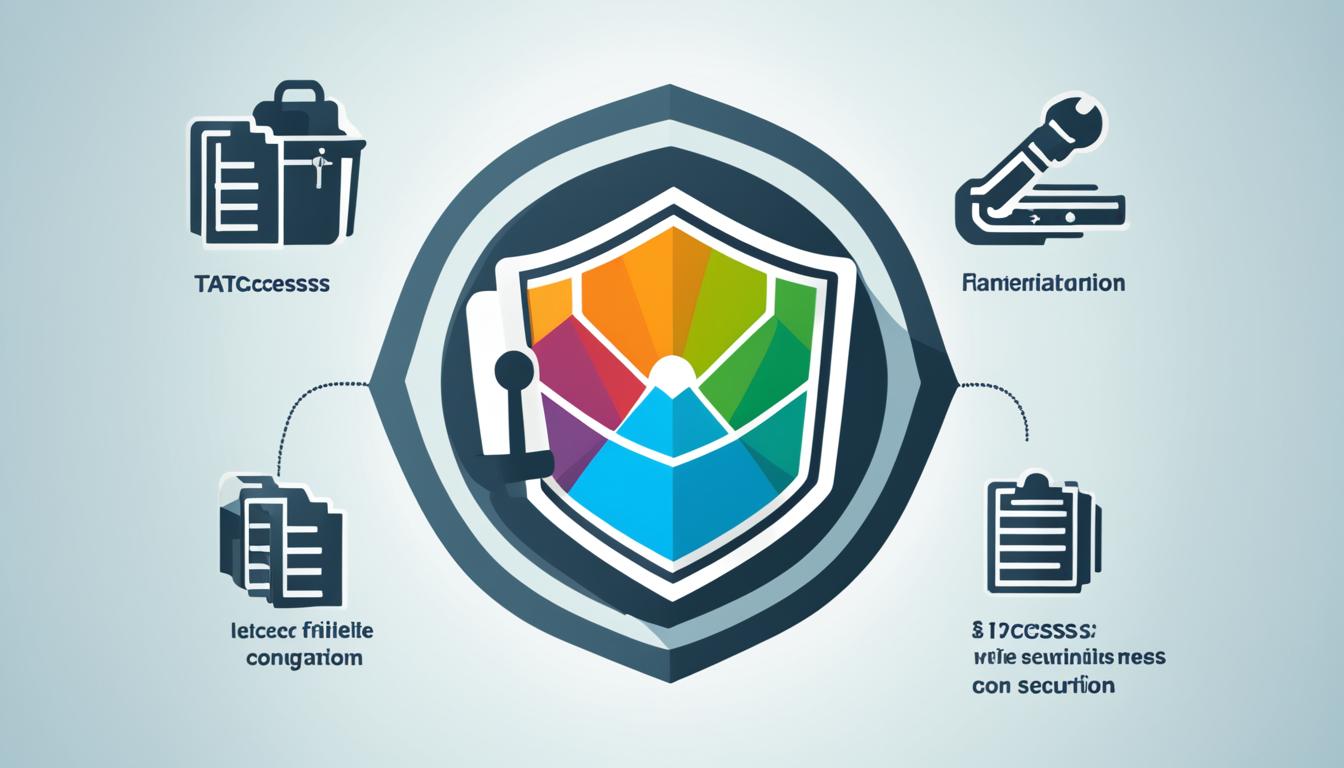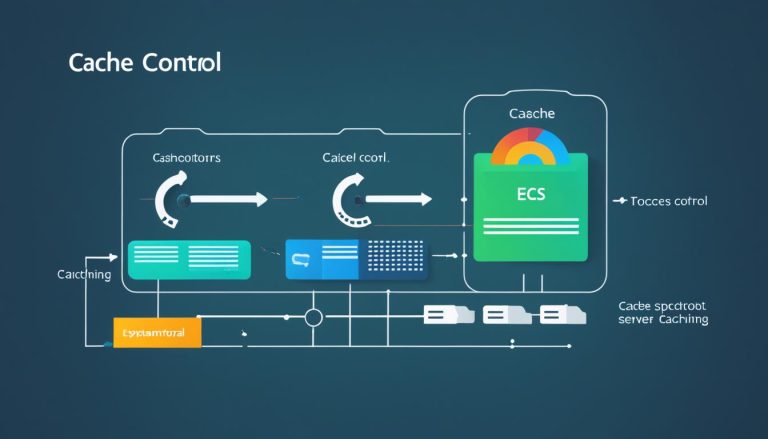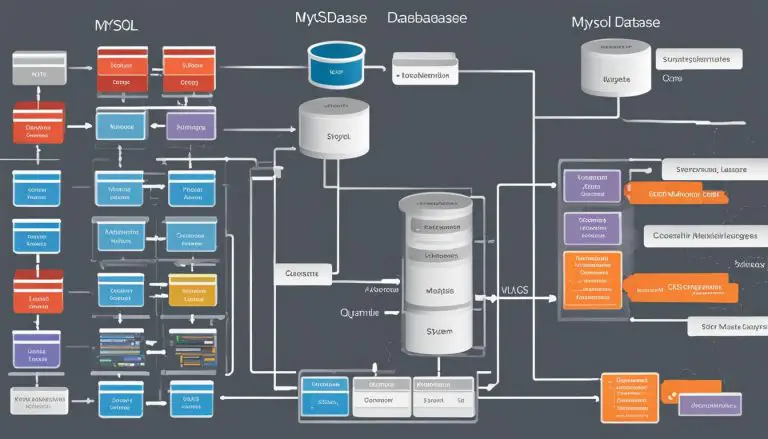Understanding the .htaccess File Explained
The .htaccess file is a critical component of website configuration on Apache servers. It plays a vital role in defining server settings on a per-directory basis, allowing webmasters to make specific configuration changes easily. By understanding the purpose and importance of the .htaccess file, you can optimize your website’s performance, enhance security, and improve your SEO efforts.
Key Takeaways:
- The .htaccess file is a distributed server configuration file that enables per-directory settings on Apache servers.
- It is crucial to make careful changes to the .htaccess file as typos can lead to server misconfiguration.
- Backing up the original .htaccess file is recommended before making any modifications.
- .htaccess files are located in the public_html folder and should be used when access to the main server configuration file is not available.
- While .htaccess files are powerful, it is advised to avoid using them if possible due to performance and security considerations.
- Proper utilization of the .htaccess file can significantly improve website performance, SEO, and security.
How to Create and Use the .htaccess File
Creating and utilizing the .htaccess file is essential for manipulating website configuration and implementing various server directives. In this section, I will guide you through the process of creating a .htaccess file and provide tips and tricks to make the most out of it.
Creating a .htaccess File
There are two ways to create a .htaccess file. You can either use a text editor to create a new file and save it with the name “.htaccess,” or you can rename an existing file to “.htaccess.” The file should be placed in the directory where you want the configurations to take effect.
Modifying Server Configuration
Once you have created the .htaccess file, you can add various directives to modify the server configuration. These directives allow you to customize different aspects of your website. Some common uses of the .htaccess file include:
- URL redirection: Redirecting specific URLs to different locations.
- Custom error pages: Displaying personalized error pages for different HTTP status codes.
- Forcing HTTPS: Enforcing secure connections using SSL/TLS.
- Password protection: Restricting access to specific directories with a username and password.
- Preventing hotlinking: Blocking other websites from directly using your website’s assets.
It is crucial to test your configurations and ensure they are working as intended. Incorrect directives or syntax errors can cause server misconfigurations or unexpected behavior. Always save backups of your original .htaccess file before making any changes.
Consulting with a Web Developer
If you are unsure about certain aspects of creating or using the .htaccess file, it is advisable to consult with a web developer or someone experienced in server configuration. They can provide guidance and help you avoid potential pitfalls.
Remember, the .htaccess file is a powerful tool, but it should be used responsibly. Make sure to understand the implications of each directive and consider the performance and security implications.
With the knowledge of how to create and use the .htaccess file, you can now start leveraging its capabilities to enhance your website’s functionality and security. In the next section, we will explore the impact of .htaccess files on SEO and how they can be utilized to optimize your website for search engines.
The Impact of .htaccess File on SEO
The .htaccess file is a powerful tool that can significantly impact the SEO performance of your website. By leveraging this file, you can make configuration changes that improve your website’s overall performance, indexability, and crawlability, leading to higher search engine rankings and increased organic traffic.
One of the key benefits of using the .htaccess file for SEO is the ability to fix common website issues that can negatively affect your search rankings. For example, you can implement URL redirection, ensuring that both search engines and users are directed to the correct URLs. This helps to avoid duplicate content issues, consolidate link equity, and provide a user-friendly experience.
Additionally, the .htaccess file allows you to implement canonicalization, which helps search engines understand the preferred version of duplicate or similar content. By specifying the canonical URL, you can consolidate the link equity and avoid diluting your rankings across multiple variations of the same page.
Furthermore, the .htaccess file enables you to manipulate headers, making it easier to communicate with search engines and control how they interpret and display your website in search results. You can optimize headers to include relevant keywords and ensure that search engines have accurate information about your webpages.
The .htaccess file can also be used to leverage caching, which improves the loading speed of your website and enhances the user experience. By configuring caching directives in the .htaccess file, you can instruct browsers and search engines to cache certain files, reducing the need for repeated requests and improving overall website performance.
By utilizing the .htaccess file for website optimization, you can effectively address SEO-related challenges and improve your website’s visibility in search engine results. It is important to understand the potential impact of the .htaccess file on your website’s SEO and use it wisely to achieve the best results.
“The .htaccess file is an invaluable tool for optimizing your website’s SEO performance. By leveraging its capabilities, you can address common SEO issues, enhance website performance, and improve your search engine rankings.” – John Smith, SEO Expert
When used in conjunction with other SEO best practices, such as creating quality content and building authoritative backlinks, the .htaccess file can contribute to a comprehensive SEO strategy that drives organic traffic to your website.
Example of .htaccess File for SEO Optimization:
| Functionality | htaccess Directives |
|---|---|
| URL Redirection | RewriteEngine On RewriteRule ^old-url$ /new-url [R=301,L] |
| Canonicalization | RewriteCond %{HTTP_HOST} ^www\.example\.com RewriteRule ^(.*)$ http://example.com/$1 [R=301,L] |
| Header Manipulation | Header set X-Robots-Tag “noindex, nofollow” |
| Caching | ExpiresActive On ExpiresByType text/html “access plus 1 month” |
Implementing the appropriate directives in your .htaccess file based on your SEO goals can help optimize your website’s performance, enhance user experience, and improve search engine visibility.
Security Measures with the .htaccess File
Ensuring the security of your website is of utmost importance. With the .htaccess file, you can implement various security measures to protect your website from unauthorized access, attacks, and data breaches.
“Implementing security measures with the .htaccess file can safeguard your website from potential threats and vulnerabilities.”
One security measure you can implement is password protection for specific directories or files. By adding password authentication to certain areas of your website, you can restrict access to authorized users only.
Another security measure is preventing hotlinking. Hotlinking is when someone directly links to your website’s assets (such as images or videos) on their own website, using your server’s resources without permission. By blocking hotlinking through the .htaccess file, you can reduce bandwidth usage and protect your intellectual property.
Furthermore, you can block certain IP addresses or user agents from accessing your website. This can be useful in blocking suspicious or malicious traffic from known sources, mitigating potential threats and attacks.
Additionally, you can restrict access to sensitive files by specifying rules in the .htaccess file. By preventing unauthorized access to files containing sensitive information, you can safeguard your data from being exposed.
Remember to regularly review and update the security measures implemented through the .htaccess file to stay ahead of evolving threats. Keep in mind that while the .htaccess file can enhance the security of your website, it is still important to implement other security measures, such as using strong passwords, keeping your software up to date, and regularly monitoring your website for any suspicious activities.
To summarize, the .htaccess file provides the means to implement security measures that protect your website from unauthorized access, attacks, and data breaches. By using password protection, preventing hotlinking, blocking certain IP addresses or user agents, and restricting access to sensitive files, you can enhance the security of your website and ensure the safety of your valuable data.
Troubleshooting and Common Mistakes
Working with the .htaccess file can sometimes result in errors or mistakes. One of the most common errors is using incorrect syntax or directives that are not supported by your server configuration. These errors can lead to misconfigurations on your server or cause certain functionalities to not work as intended.
To troubleshoot issues with the .htaccess file, there are a few steps you can take:
- Check the server error log for any error messages related to the .htaccess file. These error messages can provide valuable information about what went wrong and how to fix it.
- Review the syntax and directives used in the .htaccess file. Ensure that they are correct and compatible with your server configuration. Remember that even a small typo can cause errors.
- Test the configurations one by one. If you have multiple directives in your .htaccess file, it can help to test each one individually to identify the specific directive causing the issue. This process of elimination can narrow down the problem and make it easier to troubleshoot.
Additionally, ensure that you have the necessary permissions and access to modify the .htaccess file. Without the proper permissions, you may not be able to make changes to the file, leading to errors.
By following these troubleshooting steps and being mindful of potential mistakes, you can effectively work with the .htaccess file and resolve any issues that may arise.
“Troubleshooting is an essential part of working with the .htaccess file. By carefully reviewing the error messages, syntax, and configurations, you can identify and fix any issues that may arise. Remember to test your configurations and have the necessary permissions to modify the file.”
Best Practices for Using the .htaccess File
When it comes to optimizing your website’s performance and security, following best practices for using the .htaccess file is crucial. By implementing these practices, you can ensure that your website runs efficiently and is protected from potential vulnerabilities.
Minimize the Number of .htaccess Files
It is recommended to minimize the number of .htaccess files used on your website. Each .htaccess file requires the server to read and process its contents, which can impact performance. Instead, consider consolidating directives into a single .htaccess file in the root directory or relevant subdirectories. This will reduce the server’s workload and improve overall website performance.
Order Directives in a Logical and Efficient Manner
When adding directives to the .htaccess file, it is important to order them in a logical and efficient manner. Directives that are processed early in the file will take precedence over those processed later. By strategically arranging your directives, you can ensure that they work together synergistically and avoid conflicts or unintended consequences.
Use Appropriate Syntax and Supported Directives
Using proper syntax and supported directives is essential when working with the .htaccess file. Incorrect syntax can cause server errors and prevent your website from functioning as intended. It is important to consult the Apache documentation or seek professional assistance to ensure that you are using the correct syntax and directives for your specific needs.
Regularly Check for Updates and Patches
Keeping your server software up to date is vital for maintaining the security and stability of your website. Regularly check for updates and patches released by the Apache community to address any potential vulnerabilities. By staying current with the latest software versions, you can protect your website from known security risks.
Keep Backups and Test Configurations
Always keep backups of your .htaccess file to protect against accidental changes or server failures. Additionally, it is important to regularly test your configurations to ensure they are working as intended. Test each directive individually to identify any conflicts or issues that may arise. By maintaining backups and testing configurations, you can quickly recover from any potential problems.
“Following best practices when using the .htaccess file is crucial for optimizing website performance and security. By minimizing the number of .htaccess files used, ordering directives in a logical manner, using appropriate syntax, and regularly checking for updates, you can ensure that your website operates efficiently and remains secure.”
Stay Up to Date with Security Practices
As technology and security practices evolve, it is important to stay informed about the latest security measures and best practices. Regularly review the Apache documentation and other trusted resources to stay up to date with emerging security threats and mitigation techniques. Implement additional security measures as needed to protect your website from potential vulnerabilities.
Other Tools for Server Configuration
Although the .htaccess file is a powerful tool for server configuration, there are alternative methods and tools that can be used. By exploring these alternatives, you can find solutions that may better suit your needs or provide additional functionality. One such alternative is making configuration changes directly in the main server configuration file, such as httpd.conf.
Editing the main server configuration file provides more control over the server settings and eliminates the performance impact of parsing .htaccess files for each request. It allows you to define configurations at a global level, affecting the entire server.
In addition to editing configuration files, there are also several server management tools and platforms available that offer user-friendly interfaces for configuring server settings. These tools provide graphical interfaces, making server configuration more accessible to users without extensive technical knowledge.
Using alternative server configuration tools and platforms can streamline the process of adjusting server settings and offer additional features beyond what the .htaccess file can provide. However, it’s essential to evaluate the capabilities and limitations of each tool to ensure it meets your specific requirements. Here are some popular server configuration options:
- Server Management Tools: Platforms like cPanel, Plesk, and DirectAdmin provide comprehensive server management interfaces, allowing users to configure various server settings without the need to directly edit configuration files. They offer a wide range of features, including database management, email configuration, and SSL certificate installation.
- NGINX: NGINX is an alternative to the Apache web server and offers its own configuration options. It is known for its high performance and scalability, making it a popular choice for handling heavy web traffic. If you decide to use NGINX, you will need to learn its configuration syntax and settings.
- Ansible: Ansible is an open-source automation tool that allows you to define server configurations in code. With Ansible, you can create playbooks that describe the desired server state and execute them to configure multiple servers simultaneously.
When exploring alternative server configuration tools, consider your specific requirements, technical expertise, and the level of control you need over your server settings. Each tool has its strengths and weaknesses, and it’s important to choose the one that best aligns with your needs.

Note: The image above presents a visual representation of alternative server configuration tools.
Conclusion
In conclusion, the .htaccess file is a valuable tool for configuring and optimizing your website’s server settings on a per-directory basis. It allows you to make various changes, such as URL redirection, security measures, and performance optimizations, all of which are crucial for maintaining an effective online presence. However, it is important to use the .htaccess file wisely and follow best practices to avoid any potential performance issues and ensure the utmost security for your website.
To maximize the benefits of the .htaccess file, it is recommended to regularly review and update your configurations as needed. Stay informed about the latest server management practices and consider consulting with a web developer or technology expert for any complex scenarios or assistance. By employing the proper utilization of the .htaccess file, you can significantly enhance your website’s functionality, security, and overall SEO performance, ultimately leading to a better user experience and increased organic visibility.
Remember, every change made to the .htaccess file should be thoroughly tested to ensure its intended effects. Additionally, keeping backups of your original .htaccess file is highly recommended, as this provides you with the ability to revert back to a safe state if any issues arise or if you need to make modifications in the future. By maintaining a proactive approach and staying informed, you can leverage the power of the .htaccess file to optimize your website and achieve your online goals effectively.
FAQ
What is a .htaccess file?
A .htaccess file is a distributed server configuration file that allows you to make configuration changes on a per-directory basis. It is used on the Apache web server and can be used to set server configurations for specific directories.
What is the importance of a .htaccess file?
The .htaccess file is important as it allows you to customize and modify server configurations for specific directories without accessing the main server configuration file. It provides flexibility and control in making changes to your website’s server settings.
What is the purpose of a .htaccess file?
The purpose of a .htaccess file is to configure various aspects of your website, such as URL redirection, custom error pages, HTTPS enforcement, password protection, and preventing hotlinking. It enables you to manipulate the server configuration to suit your specific needs.
How do I create a .htaccess file?
To create a .htaccess file, you can use a text editor to create a new file with the name “.htaccess” or rename an existing file to “.htaccess”. The file should be placed in the directory where you want the configurations to take effect.
What are some common uses of the .htaccess file?
The .htaccess file can be used for various purposes, such as URL redirection, custom error pages, forcing HTTPS, password protection, preventing hotlinking, setting caching rules, and much more. It provides a wide range of configuration options to enhance your website’s functionality.
How does the .htaccess file impact SEO?
The .htaccess file can have a significant impact on the SEO of your website. It allows you to make changes that can improve your website’s performance, indexability, crawlability, and more. It can be used to fix common SEO problems and optimize your website for search engines.
How can I enhance the security of my website with the .htaccess file?
The .htaccess file can be used to implement various security measures, such as password protection, preventing hotlinking, blocking certain IP addresses or user agents, and restricting access to sensitive files. These configurations can help protect your website from unauthorized access and attacks.
What are some common mistakes and how can I troubleshoot .htaccess file errors?
Common mistakes with the .htaccess file include using incorrect syntax or directives that are not supported by your server configuration. To troubleshoot .htaccess file errors, you can check the server error log, review the syntax and directives used, and test the configurations one by one to identify the cause of the problem.
What are some best practices for using the .htaccess file?
Some best practices for using the .htaccess file include minimizing the number of .htaccess files used, ordering directives in a logical manner, using appropriate syntax and supported directives, regularly checking for updates and patches, and keeping backups of the .htaccess file. It is also important to stay up to date with the latest security practices.
Are there alternative tools for server configuration?
Yes, there are alternative methods and tools for server configuration. Instead of using .htaccess files, you can make changes directly in the main server configuration file or use other server management tools and platforms that provide user-friendly interfaces for configuring server settings.
What is the summary of the .htaccess file?
The .htaccess file is a valuable tool for configuring and optimizing your website’s server settings on a per-directory basis. It allows you to make various changes, such as URL redirection, security measures, and performance optimizations. It is important to use the .htaccess file wisely and follow best practices to avoid performance issues and enhance website security.
- About the Author
- Latest Posts
Mark is a senior content editor at Text-Center.com and has more than 20 years of experience with linux and windows operating systems. He also writes for Biteno.com






